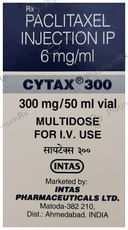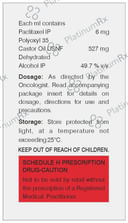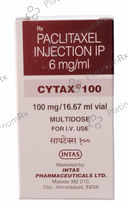Paclitaxel
Uses
Paclitaxel is used in the treatment of breast cancer, non-small cell lung cancer, and pancreatic cancer.
How it Works
How Paclitaxel Works Paclitaxel is an anticancer medication that functions by interfering with the microtubule structures, which are essential for cancer cell division and multiplication. This action slows the growth of cancer cells and ultimately leads to their death.
Side Effects
Common side effects of Paclitaxel include nausea, vomiting, rash, low blood platelets, urinary tract infection, anemia (low red blood cell count), hair loss, diarrhea, decreased white blood cell count (neutrophils), edema (swelling), joint pain, muscle pain, infection, sensory neuropathy, abnormal ECG, fatigue, increased bilirubin in the blood, increased aspartate aminotransferase, increased alkaline phosphatase level in the blood, fever, pneumonia, decreased appetite, visual disturbances, increased gamma-glutamyltransferase, depression, cough, hypotension (low blood pressure), cardiovascular reactions, increased creatinine level in the blood, and pneumonitis.
Expert Advice
- Paclitaxel is an anti-cancer medication used for the treatment of:
- Breast cancer
- Pancreatic cancer
- Non-small cell lung cancer
- It is administered as an intravenous (IV) injection into your vein, typically over 1 hour and every three weeks.
- Do not take Paclitaxel if you are pregnant or breastfeeding.
- Use reliable methods of contraception to prevent pregnancy while taking this medication.
- Your doctor may perform regular blood tests to monitor:
- Blood cell counts
- Liver function
- Inform your doctor if you notice:
- Unexplained bruising or bleeding
- Sore throat
- Mouth ulcers
- High temperature (fever)
- Other signs of infection
- Consult your doctor if you experience:
- Sudden weight gain
- Swelling in your arms and legs that does not go away
Other Combinations
Albumin + Paclitaxel
Related Medications
Paclitaxel 30mg

₹1,944

₹359.8
MRP ₹438.8
Paclitaxel 30mg

₹1,035

₹359.8
MRP ₹438.8
Paclitaxel 30mg

₹1,085

₹359.8
MRP ₹438.8
Paclitaxel 30mg

₹1,175

₹359.8
MRP ₹438.8
Paclitaxel 30mg

₹445.2

₹359.8
MRP ₹438.8
Paclitaxel 300mg

₹12,600

₹8,143.6
MRP ₹11,310.6
Paclitaxel 300mg

₹11,639.8

₹8,143.6
MRP ₹11,310.6
Paclitaxel 6mg

₹5,878.1
MRP ₹9,796.9
Paclitaxel 6mg

₹4,029

₹5,878.1
MRP ₹9,796.9
Paclitaxel 6mg

₹1,223

₹5,878.1
MRP ₹9,796.9
Paclitaxel 260mg

₹9,000

₹980.6
MRP ₹1,400.9
Paclitaxel 260mg

₹10,790

₹980.6
MRP ₹1,400.9
Paclitaxel 260mg

₹9,500

₹980.6
MRP ₹1,400.9
Paclitaxel 260mg

₹10,400

₹980.6
MRP ₹1,400.9
Paclitaxel 260mg

₹4,940.5

₹980.6
MRP ₹1,400.9
Paclitaxel 260mg

₹7,661.6

₹980.6
MRP ₹1,400.9
Paclitaxel 260mg

₹7,700

₹980.6
MRP ₹1,400.9
Paclitaxel 100mg

₹3,601
₹1,888.6
MRP ₹3,777.2
Paclitaxel 100mg

₹1,330.7
₹1,888.6
MRP ₹3,777.2
Paclitaxel 100mg

₹5,000
₹1,888.6
MRP ₹3,777.2
Paclitaxel 100mg

₹3,458
₹1,888.6
MRP ₹3,777.2
Paclitaxel 100mg

₹4,500
₹1,888.6
MRP ₹3,777.2
Paclitaxel 100mg

₹9,000
₹1,888.6
MRP ₹3,777.2
Paclitaxel 100mg

₹3,600
₹1,888.6
MRP ₹3,777.2
Paclitaxel 100mg

₹4,022.2
₹1,888.6
MRP ₹3,777.2